Good speaker coverage is one of the most crucial aspects of successfully setting up a sound system. There are complex formulas and software to help calculate how to get full sound coverage in your space. In reality, however, varying room shapes, ceiling heights, and many other factors make this process just as much an art as it is a science, and there are many different ways to achieve your solution. Simply having a good understanding of speaker dispersion angles and paying attention to the best speakers to use for a particular application will be your best mechanism.
Our goal here is to give you some of those tools. We are going over the different types of speaker dispersion patterns, dispersion angles and explaining what these terms mean and why they matter to ensure your sound system provides proper coverage.

Consistent Coverage
One important thing is to maintain consistent audio coverage throughout your space. That means you want to try and have no more than 6dB variation in the sound pressure levels (SPL). Staying within a 6dB variation will prevent the space from having super loud spots in the front and quiet areas in the back. Keep in mind that consistent coverage is the ideal outcome but is rarely 100% attainable. However, the closer you can get, the better the listening experience will be for your audience.
Horizontal & Vertical Speaker Coverage
Most speakers will have two different axes, horizontal (width) and vertical (height). Speakers will have diverse coverage angles based on the two axes. The horizontal and vertical coverage lets you know where the best sound for that speaker design will be and allows you to adjust the placement based on the venue's needs.
Horizontal Speaker Coverage
The main concern with horizontal coverage is ensuring you reach all the audience on both sides with minimal overlap. The more the speaker drivers overlap, the more likely you will produce phasing from sound wave interference.
What is phasing in audio?
Phasing can cause hotspots, areas that are louder than other areas, or cancellation, where there is not enough sound. If two different speakers point at the same place, their sound waves will interfere with one another. This interference creates either too much of one particular frequency (hotspot) or not enough of a frequency (cancellation).
Mono Versus Stereo Sound Systems
When considering horizontal coverage, you may also want to look at whether you need a stereo system or if a mono system might be better.
When you mention stereo, most people think that stereo systems sound better. Stereo means that different information is coming out of the left speaker versus the right speaker. With a stereo system, you are getting varying audio coming out of the two speakers. The stereo experience can change dramatically throughout the venue and create a greater risk of phasing issues.
A single mono speaker or mono speaker array is enough to cover some spaces. A mono system can help prevent some of these horizontal coverage issues. So it is worth considering.
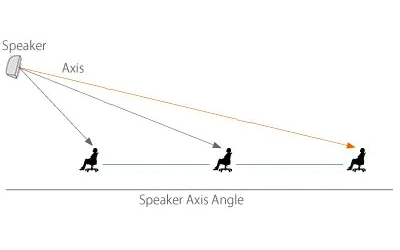
Vertical Speaker Coverage
Vertical coverage determines how high the speaker pattern comes out. The speaker height, where you need to direct the speaker, and the distance to place it from the audience all come into play. A large part of good speaker coverage is finding a balance between where to put the speaker and how loud the speaker will be. You want to make sure and keep the speaker high up off the ground where it can throw sound to the back of the room but still cover the area. You want the balance of pointing the speaker directly at the people as much as possible, far enough away to get the best coverage, but not so far away that you lose volume.

Fill-in Speakers
Sometimes it may be necessary to add what is called fill-in speakers. Fill-in speakers are smaller speakers added in either the very back or front of the room or the balcony. These speakers help to cover areas that your main speakers are unable to reach. Fill-in speakers can be helpful in larger venues or when dealing with balconies in theaters, churches, or auditoriums.
Speaker Coverage Challenges
Every venue ultimately has its specific coverage challenges. For example, in a dance club with low ceilings, it is difficult to ensure high sound pressure levels cover at the back. A custom sound system design can come through to help resolve any issues.
Dispersion Patterns
Most loudspeakers have a sound projection pattern or dispersion pattern. Dispersion refers to waveguides, a portion of the speaker, usually a horn-like shape, primarily attached to the high-frequency driver or sometimes integrated into the speaker cabinet design. The waveguides do what you can probably guess by the name. They guide the sound waves to determine the coverage pattern of the speaker.
Speakers with a broad dispersion pattern create a larger sound field and a more consistent listening experience. A more broad dispersion also means the speakers are more forgiving with where you place them.
How wide a speaker will cover versus how high it covers is generally related to the physical size and shape of the speaker itself. However, sometimes speakers can have a variety of different coverage angles.
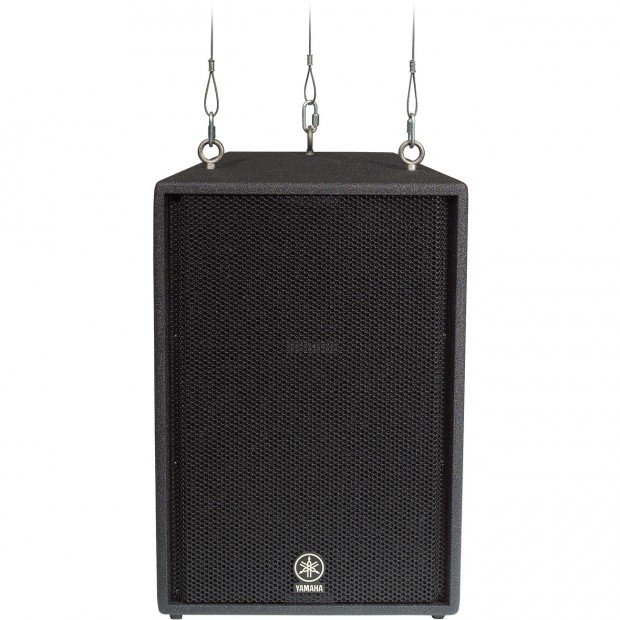
Vertical & Horizontal Speaker Dispersion Angles
The Yamaha C115VA 15" loudspeaker, for instance, has a 90 degree by 40 degrees CD (Constant Directivity) horn symmetrical coverage pattern. The first degree refers to the horizontal coverage, and the second degree refers to the vertical angle. If you think of being straight on-axis with the speaker, a 90-degree speaker coverage angle means it is 45 degrees on both sides, so it is symmetrical.
NOTE: There are some asymmetrical coverage pattern speakers out there, but those get a little more complicated. If you think something like that might be applicable for you, reach out to us, and we will be happy to talk it over more.
90 by 40 degrees is a typical dispersion angle of a speaker. 90 by 60 degrees is another standard angle with a slightly higher vertical pattern. Something important to consider here is that if you were to mount the speaker sideways, you take that same dispersion pattern and rotate it giving you a 90-degree vertical speaker coverage pattern. Some speakers also have a rotatable waveguide enabling you to pivot the horn inside the speaker instead of the speaker itself.
It is particularly significant to look at dispersion angles for stadium speakers. Companies like Yamaha Professional, AtlasIED, JBL Professional, and Community Loudspeakers have 90 by 90, 60 by 60, or 50 by 20-degree coverage angles. The dispersion pattern is significant for stadiums because it can impact how far the speaker will throw. With 50 by 20, for instance, you are getting a very narrow dispersion, so you can throw sound across a football field and still have it sound nice and rich.
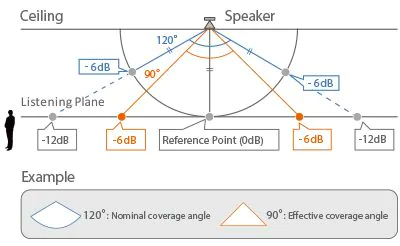
Ceiling Speaker Coverage Patterns
Questions about dispersion often come up with ceiling speakers as well. The ceiling speaker is a little more unique. Instead of having a horizontal and vertical pattern, they have a conical or cone shape dispersion, usually in 100 degrees or 130 degrees, but some are as high as 180 degrees. That means the speaker disperses sound 180 degrees when factoring all directions. The idea is that, with a ceiling speaker, it will point down, so you want it to have a nice even pattern outwards so that regardless of where you stand, it sounds the same.
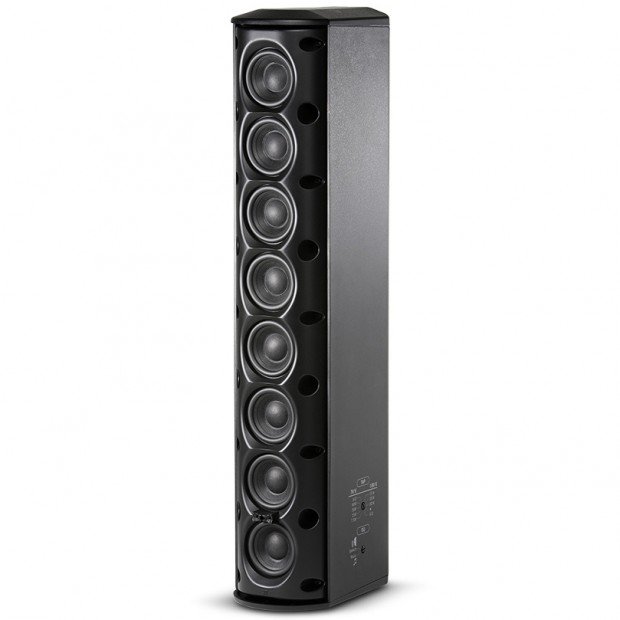
Line Array & Column Array Speakers
You have probably heard the term line array come up. Line arrays combine lots of individual speakers to create a larger dispersion pattern. Column arrays are a type of line array that has a lot of individual speakers firing straight ahead. Most of these have wide dispersion angles but very narrow vertical patterns allowing you to point the speaker exactly where you want it. In a situation like a Catholic church or places that have lots of hard surfaces, you can aim the speaker directly where the audience is and keep sound waves from bouncing off the floor or other surfaces.
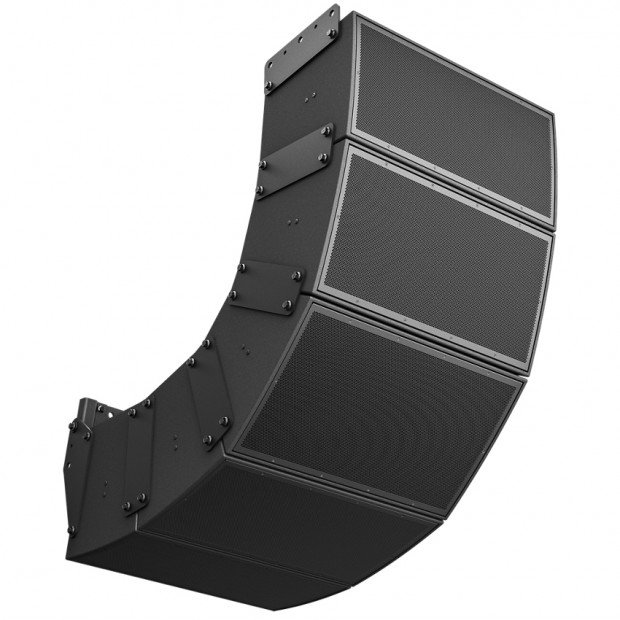
Variable Dispersion Speakers
There are also line arrays with variable dispersion. These would usually be concert-style speakers, sometimes called banana speakers, with lots of individual speaker boxes hung from one another to make a banana shape. These speakers are variable in that you can adjust the dispersion of the individual speakers to tailor the sound for your space.
Use Your Ears
When purchasing your audio equipment, you want to consult a professional and ensure you get the right coverage angle for your space. Regardless of the venue, speaker coverage angles, or specified dispersion pattern of the speakers, when fine-tuning your sound system, you need to use your ears. Take the time to walk around the space and listen. Are you pointing the speaker(s) at the right location? Does the space sound particularly noisy? Are you aiming the speaker(s) too much at the ground or a wall? Do you need to possibly rotate the speaker(s) to change the acoustic properties and the dispersion angle?
If you have more questions about speaker dispersion angles and coverage patterns or what speakers might work best for your venue, email us at [email protected] or call (888) 256-4112, and we would love to help out.

